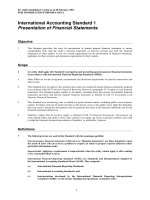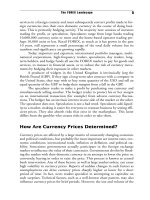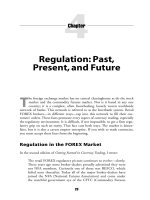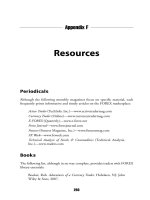Lecture Accounting: What the numbers mean (5/e) - Chapter 6: Accounting for and presentation of property, plant, and equipment, and other noncurrent assets
Bạn đang xem bản rút gọn của tài liệu. Xem và tải ngay bản đầy đủ của tài liệu tại đây (166.5 KB, 43 trang )
CHAPTER 6
ACCOUNTING FOR AND
PRESENTATION OF
PROPERTY, PLANT, AND
EQUIPMENT, AND OTHER
NONCURRENT ASSETS
McGrawHill/Irwin
©The McGrawHill Companies, Inc., 2002
Learning Objectives
1. How are the costs of land, buildings, and
equipment reported on the balance
sheet?
2. How are the terms capitalize and expense
used with respect to property, plant, and
equipment?
3. What are the alternative methods of
calculating depreciation for financial
accounting purposes, and what are the
relative effects of each on the income
statement (depreciation expense) and the
balance sheet (accumulated
depreciation)?
McGrawHill/Irwin
©The McGrawHill Companies, Inc., 2002
Learning Objectives
4. Why is depreciation for income tax
purposes an important concern of taxpayers, and how does tax depreciation
differ from financial accounting
depreciation?
5. What is the accounting treatment of
maintenance and repair expenditures?
6. What is the effect on the financial
statements of the disposition of noncurrent
assets either by abandonment or sale?
7. What is the difference between and
operating lease and a capital lease?
McGrawHill/Irwin
©The McGrawHill Companies, Inc., 2002
Learning Objectives
8. What are the similarities in the financial
statement effects of buying an asset
compared to using a capital lease to
acquire the rights to an asset?
9. What are the meanings of various
intangible assets, how are their values
measured, and how are their costs
reflected in the income statement?
10. What is the role of present value concepts
in financial reporting, and what is their
usefulness in decision making?
McGrawHill/Irwin
©The McGrawHill Companies, Inc., 2002
Learning Objective 1
• How are the costs of land,
buildings, and equipment reported
on the balance sheet?
McGrawHill/Irwin
©The McGrawHill Companies, Inc., 2002
Land
• Shown on the balance sheet at its original
cost
• Cost includes all ordinary and necessary
items to get the land ready for its intended
use
• Land acquired for investment or potential
future use is classified as a noncurrent,
nonoperating asset
• Land is not depreciated
• Gains and losses on the sale of land are
recognized as the difference between the
cost of the land and the amount received
McGrawHill/Irwin
©The McGrawHill Companies, Inc., 2002
Learning Objective 2
• How are the terms capitalize and
expense used with respect to
property, plant, and equipment?
McGrawHill/Irwin
©The McGrawHill Companies, Inc., 2002
Capitalization
• Expenditures should be capitalized if the item
acquired will have an economic benefit beyond
the current fiscal year
• Capitalized assets – except land – are
depreciated
• Depreciation expense is recognized over the
useful life of the asset
• Materiality concept is applied to capitalization
• Accounting judgment plays a role in
determination of capitalization
McGrawHill/Irwin
©The McGrawHill Companies, Inc., 2002
Expense
• Expenditures should be expensed if the
item acquired will not have an economic
benefit beyond the current fiscal year
• Expenditures for preventive
maintenance are expensed
• Items are expensed if their costs are not
material, even if they have a useful life of
several years
McGrawHill/Irwin
©The McGrawHill Companies, Inc., 2002
Learning Objective 1
• How are the costs of land,
buildings, and equipment reported
on the balance sheet?
McGrawHill/Irwin
©The McGrawHill Companies, Inc., 2002
Buildings and Equipment
• Recorded at original cost
• Cost includes all ordinary and necessary
costs to get the asset ready to use
• Interest costs associated with the loans used
to finance construction are capitalized until
the building is put in operation
• Installation costs and shake-down costs are
capitalized
• Self-manufactured asset cost includes
materials, labor, and overhead costs
McGrawHill/Irwin
©The McGrawHill Companies, Inc., 2002
Basket Purchase Allocation
• When two or more items are purchased
in a single transaction, the cost of each
asset must be determined
• The allocation of the purchase price is
made based on the relative appraisal
values of each asset to the total
• See Exhibit 6-2 in text
McGrawHill/Irwin
©The McGrawHill Companies, Inc., 2002
Depreciation for Financial
Accounting Purposes
• An application of the matching concept
since an asset is a prepaid cost
• A portion of the cost should be
subtracted from the revenues that are
generated through the use of the asset
• Depreciation is the allocation of the cost
of an asset to the time periods
benefited
McGrawHill/Irwin
©The McGrawHill Companies, Inc., 2002
Recording Depreciation
• The expense “Depreciation Expense” is
increased
• The contra asset account “Accumulated
Depreciation” is increased
• The journal entry is as follows:
Depreciation Expense
XX
Accumulated Depreciation
McGrawHill/Irwin
XX
©The McGrawHill Companies, Inc., 2002
Depreciation Details
• The balance in the Accumulated
Depreciation account is the cumulative
total of all depreciation expense
recorded over the life of the asset
• Net book value is the cost of the asset
less the accumulated depreciation
• Note: cash is not involved in the
depreciation entry
McGrawHill/Irwin
©The McGrawHill Companies, Inc., 2002
Learning Objective 3
• What are the alternative methods of
calculating depreciation for financial
accounting purposes, and what are the
relative effects of each on the income
statement (depreciation expense) and
the balance sheet (accumulated
depreciation)?
McGrawHill/Irwin
©The McGrawHill Companies, Inc., 2002
Depreciation Methods
• Accelerated depreciation results in
greater depreciation expense and lower
net income during the early years of an
asset’s life
• Straight-line depreciation results in
even amounts of depreciation being
taken over the life of the asset
McGrawHill/Irwin
©The McGrawHill Companies, Inc., 2002
Depreciation Calculation
Methods
• The specific depreciation calculation
methods are:
– Straight-line
– Units of production
– Sum-of-the-years’-digits
– Declining balance
McGrawHill/Irwin
©The McGrawHill Companies, Inc., 2002
Straight-Line Depreciation
• Annual amount of depreciation is
calculated as follows:
Cost – Estimated salvage value
Estimated useful life
• The same amount of depreciation
expense is taken each year
McGrawHill/Irwin
©The McGrawHill Companies, Inc., 2002
Units-of-Production Depreciation
• The depreciation expense per unit
produced is calculated as follows:
Cost – Estimated salvage value
Estimated total units to be made
• The depreciation expense for the period
is calculated by multiplying the number
of units produced that period times
the depreciation expense
per unit
McGrawHill/Irwin
©The McGrawHill Companies, Inc., 2002
Sum-of-the-Years’ Digits
Depreciation
• Annual depreciation expense is calculated
as follows:
(Cost – Estimated salvage value) x
Remaining life in years
Sum-of-the-years’ digits
• Results in greater depreciation
expense earlier in the life
of the asset
McGrawHill/Irwin
©The McGrawHill Companies, Inc., 2002
Declining-Balance Depreciation
• Annual depreciation expense is
calculated as follows:
Double the
straight-line
depreciation rate
X
Asset’s net book
value at beginning
of year
• Greater depreciation expense is
taken earlier in the life of the asset
McGrawHill/Irwin
©The McGrawHill Companies, Inc., 2002
Learning Objective 4
• Why is depreciation for income tax
purposes an important concern of
taxpayers, and how does tax
depreciation differ from financial
accounting depreciation?
McGrawHill/Irwin
©The McGrawHill Companies, Inc., 2002
Depreciation Expense for
Income Tax Purposes
• Depreciation is a deductible expense for income
tax purposes
• In 1981, ACRS was placed in use
• In 1986, MACRS lengthened the lives of the
assets for depreciation purposes and additional
categories were added
• Most firms do not use income tax depreciation
methods for financial reporting purposes – tax
rules are subject to frequent change
McGrawHill/Irwin
©The McGrawHill Companies, Inc., 2002
Learning Objective 5
• What is the accounting
treatment of maintenance
and repair expenditures?
McGrawHill/Irwin
©The McGrawHill Companies, Inc., 2002









